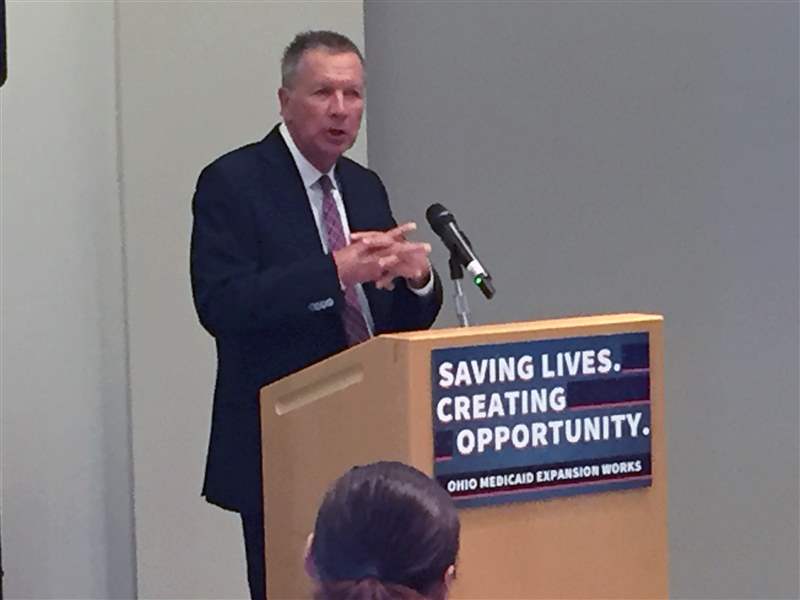
Medicaid expansion benefits state financially, study says
8/21/2018
Gov. John Kasich speaks at press conference touting the benefits of Ohio's decision to expand Medicaid coverage in partnership with the federal Affordable Care Act.
THE BLADE/JIM PROVANCE
Buy This Image
COLUMBUS — The tentacles of Ohio’s controversial expansion of Medicaid have reached deeply into the state budget, offsetting enough costs to reduce its estimated share of the price tag from 10 percent to 3.2 percent in 2021.
“It is affordable now,” said Gov. John Kasich, the program’s biggest cheerleader despite criticism from fellow Republicans.
“Now I want to be clear,” he said. “If the federal government plays games and tries to put us in a perilous fiscal position, we will have to change this position on Medicaid expansion. There’s no way that we can put our state deep in the hole and wreck economic development and more prosperity.”
In 2013, Mr. Kasich sidestepped the Republican-controlled General Assembly and turned to a relatively little known, quasi-legislative budgetary panel to partner with the Affordable Care Act and draw down billions in federal funds to launch the program.
At the time the federal government was picking up the entire tab. Fiscal year 2021 will mark the first year that the state’s share of the tab will reach 10 percent.
State Medicaid Director Barbara Sears, a former state representative from Monclova Township who also bucked those in her party to support the expansion, said the department’s second review of the program shows the expansion has helped participants find and keep jobs.
It has also helped to reduce the number of emergency room visits, slash the number of people without coverage in the state, help many quit smoking, and treat the drug addicted and mentally ill, she said..
Just under 700,000 Ohioans are covered by the program, which serves those earning as much as 38 percent above the federal poverty level, about $16,700 a year for an individual.
“Every single county, every single community, every single neighborhood is impacted,” Ms. Sears said. “You don’t know that your neighbor may just be on Medicaid through expansion or another part of our program.”
In Lucas County, nearly 33,000 people, or 12.2 percent of those between the ages of 19 and 64, are enrolled.
Lydia Gunderson, of Columbus, works for a small employer that does not offer health-care benefits, so she counts on the expansion for coverage.
“I wouldn’t be able to afford $800 [for premiums],” she said. “I wouldn’t be able to have electricity or able to put food on the table. That’s a lot of money.”
The Republican-controlled General Assembly has remained critical of the expansion but has twice passed biennial budgets that have continued funding for the program, including the state’s growing matching share.
The program extends Medicaid — the federal-state health coverage of last resort for the poor, disabled, and infirm — to include largely working, lower-income adults. Demand for the program far exceeded initial estimates.
But Tim Keen, the state’s budget director, said the expansion is a better deal for Ohio taxpayers than traditional Medicaid that covers those below the federal poverty level.
In 2021, the state’s estimated match of $163.1 million would provide $5.1 billion in health care services in Ohio, he said.
Rea S. Hederman, Jr., executive director of research and vice president of policy for the conservative Buckeye Institute think tank, questioned the value of the study.
“What we do know from the 2016 assessment, which also used self-reported surveys, is that the Department of Medicaid was unable to do the analysis it initially planned, ‘because of lower than expected participation from people who were younger, male, and living in metro counties,’” he said.
“This fact made the 2016 report useless in providing an unbiased quantitative assessment of the impact of Medicaid expansion,” Mr. Hederman said. “If the 2018 report also fails in this regard, this assessment will be similarly unhelpful.”
Preservation of the expansion is considered imperative for Mr. Kasich. He expects both major party candidates running to replace him in November, Republican Mike DeWine and Democrat Richard Cordray, to keep it.
Mr. DeWine, who won the endorsement of the Ohio State Medical Association, has called the program financially unsustainable in the long run and said he would work to change it with such things as work requirements, something Mr. Kasich is already doing.
Mr. Cordray has pledged to preserve the program and has sought to specifically nail down Mr. DeWine on specifics of the changes he’d like to make.
Contact Jim Provance at jprovance@theblade.com or 614-221-0496.